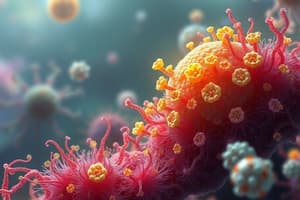Podcast
Questions and Answers
What does a cladogram illustrate in relation to evolutionary patterns?
What does a cladogram illustrate in relation to evolutionary patterns?
- The distribution of species in a geographic area
- The process of convergent evolution
- The genetic similarities among different species
- The divergence of taxa into multiple lineages (correct)
What characterizes a paraphyletic group?
What characterizes a paraphyletic group?
- It includes all descendants from a common ancestor
- It only includes the common ancestor and immediate descendants
- It consists of multiple unrelated species
- It lacks one or more descendants of the most recent common ancestor (correct)
Which statement about genetic changes and phenotypic outcomes is true?
Which statement about genetic changes and phenotypic outcomes is true?
- Genetic changes have no impact on phenotypic expression
- Phenotypic changes are always the result of large genetic changes
- All genetic changes lead to significant phenotypic changes
- Small genetic changes can sometimes lead to large phenotypic changes (correct)
What principle do systematists use to infer phylogenetic trees?
What principle do systematists use to infer phylogenetic trees?
How do systematists categorize taxonomic units?
How do systematists categorize taxonomic units?
Which of the following correctly defines a clade?
Which of the following correctly defines a clade?
What is the main focus when systematists attempt to construct cladograms?
What is the main focus when systematists attempt to construct cladograms?
What does genealogy primarily map compared to phylogeny?
What does genealogy primarily map compared to phylogeny?
What is the primary goal of modern plant systematics?
What is the primary goal of modern plant systematics?
What does phylogeny refer to in the context of systematics?
What does phylogeny refer to in the context of systematics?
Which individual is credited with the system of nomenclature that underlies modern scientific naming?
Which individual is credited with the system of nomenclature that underlies modern scientific naming?
Which term describes the classification system that groups organisms based on their evolutionary history?
Which term describes the classification system that groups organisms based on their evolutionary history?
What is the significance of binomial naming in taxonomy?
What is the significance of binomial naming in taxonomy?
Which statement about species classifications is accurate?
Which statement about species classifications is accurate?
What reflects the limitations of current classification systems?
What reflects the limitations of current classification systems?
Which ancient figure is known for the first attempt to organize and classify plants?
Which ancient figure is known for the first attempt to organize and classify plants?
What is the primary level of plant classification that defines a set of individuals that can interbreed successfully?
What is the primary level of plant classification that defines a set of individuals that can interbreed successfully?
Which term describes a group of species that are all related through a common ancestor?
Which term describes a group of species that are all related through a common ancestor?
If a group of species has evolved from different ancestors, what is the term used to describe this grouping?
If a group of species has evolved from different ancestors, what is the term used to describe this grouping?
What is the correct taxonomic ending for the 'Class' level in plant classification?
What is the correct taxonomic ending for the 'Class' level in plant classification?
Which of the following statements is true regarding synapomorphies?
Which of the following statements is true regarding synapomorphies?
Who originally coined the term related to the study of plant classification in 1813?
Who originally coined the term related to the study of plant classification in 1813?
What classification level is directly above the genus in taxonomy?
What classification level is directly above the genus in taxonomy?
Which type of features do homoplasies represent in the context of cladistics?
Which type of features do homoplasies represent in the context of cladistics?
Flashcards
Species
Species
A group of closely related individuals that can interbreed successfully and produce fertile offspring, but cannot interbreed with individuals of other species.
Genus
Genus
A group of closely related species, sharing a common ancestor.
Monophyletic Group
Monophyletic Group
A group of species that includes all descendants of a common ancestor.
Polyphyletic Group
Polyphyletic Group
Signup and view all the flashcards
Synapomorphy
Synapomorphy
Signup and view all the flashcards
Homoplasy
Homoplasy
Signup and view all the flashcards
Convergent Evolution
Convergent Evolution
Signup and view all the flashcards
Taxonomic Levels
Taxonomic Levels
Signup and view all the flashcards
Systematics
Systematics
Signup and view all the flashcards
Binomial Nomenclature
Binomial Nomenclature
Signup and view all the flashcards
Phylogeny
Phylogeny
Signup and view all the flashcards
Natural System of Classification
Natural System of Classification
Signup and view all the flashcards
Goals of Modern Plant Systematics
Goals of Modern Plant Systematics
Signup and view all the flashcards
Theophrastus
Theophrastus
Signup and view all the flashcards
Dioscorides
Dioscorides
Signup and view all the flashcards
Carolus Linnaeus
Carolus Linnaeus
Signup and view all the flashcards
Analogy (convergent evolution)
Analogy (convergent evolution)
Signup and view all the flashcards
Clade
Clade
Signup and view all the flashcards
Cladogram
Cladogram
Signup and view all the flashcards
Parsimony
Parsimony
Signup and view all the flashcards
Phylogenetic Tree
Phylogenetic Tree
Signup and view all the flashcards
Study Notes
Classifications and Systematics
- Systematics is the scientific study of biological diversity and evolutionary history
- It's a comparative science
- Prior to binomial nomenclature, plant species had excessively long names
- All living organisms have a single, two-word Latin scientific name
- Only one correct scientific name applies to all individuals of a species, regardless of variations
- Many common names can be applied to different species, but only one common name can be assigned to a species
Introduction
- Taxonomy, phylogeny, and systematics are related parts of classifying species
- Taxonomy is the method of classifying and organizing living things based on their evolutionary relationships
- Phylogeny is the study of evolutionary relationships among organisms
- Systematics involves the study of the diversity and evolutionary relationships of organisms
Background
- Systematics is the science
- Binomial nomenclature assigns a unique two-word Latin name to every species
- Scientific names provide a clear and consistent way to identify organisms
- Common names are not consistently applied to all individuals of a particular species
Concepts (1 of 2)
- Phylogeny is the hereditary relationships of any group of organisms, depicting their evolutionary history
- At the end of the 19th century, taxonomists aimed to develop natural systems of classification
- Organisms closely related, phylogenetically, are grouped (natural classification)
- Phylogenetic relationships are used to assign plant names
Concepts (2 of 2)
-
Modern plant systematics aims to interpret evolutionary lineages and produce accurate nomenclature (naming systems)
-
Phylogeny is a real process; our current classifications are hypotheses, not definitive truths
-
Our knowledge, limited and imperfect, leads to imperfect classifications
Development of Concepts of Evolution and Classification
- Modern classifications originate from ancient Greek thought
- Theophrastus, an ancient Greek philosopher and biologist, was the first to organize and classify plants
- Dioscorides, a Roman military surgeon, wrote an important ancient book on plant classification (Materia Medica)
- Linnaeus's system of binomial nomenclature was pivotal
Taxonomy
- Taxonomy is the scientific method for classifying the huge diversity of life on Earth
- It helps understand the evolutionary relationships between organisms
- Taxonomy documents biodiversity, and organizes and classifies lifeforms
Levels of Taxonomic Categories (1 of 3)
- Species is the fundamental taxonomic unit—individuals that can interbreed and produce viable offspring
- Members of a species can interbreed successfully but cannot interbreed with members of other species
- Closely-related species are grouped into genera
- Some species may interbreed to yield viable offspring
Levels of Taxonomic Categories (2 of 3)
- A group of species is monophyletic if all its members share a common ancestor
- All descendants of the common ancestor are in the same genus
- A group of species is polyphyletic if members share no common ancestor
Levels of Taxonomic Categories (3 of 3)
- The level above genus is family
- Taxon levels above family are order, class, division, and kingdom
- All but genus, species, and kingdom require specific suffixes
Cladistics (1 of 5)
- Distantly related plants evolved separately for a great deal of time
- Accumulation of mutations can result in slight resemblance even between distantly related species
Cladistics (2 of 5)
- Closely related species have descended from a common ancestor
- Similar features shared by closely-related organisms are synapomorphies (homologous features)
- Convergent evolution produces species that appear similar but do not share a common ancestor; in this case, similar structures are homoplasies (analogous features)
Cladistics (3 of 5)
- Distinguishing between homology (similarity due to common ancestry) and analogy (similarity due to convergent evolution) can be difficult
Cladistics (4 of 5)
- Studying lack of similarity can be challenging
Cladistics (5 of 5)
- Systematists try to consider as many features of organisms as possible in cladistic analysis
- Misleading information is accounted for; valid information is prioritized in analysis
Genealogy Versus Clades
- Genealogy charts genetic convergence of characters over a short period, while phylogeny charts evolutionary divergence over long periods
Cladograms (1 of 3)
-
Cladograms are diagrams that represent evolutionary patterns using branches.
-
Branching points (nodes) depict when a lineage diverges from another
-
All offshoots from a branching point represent the descendants of that original group.
Cladograms (2 of 3)
- A paraphyletic group doesn't contain all descendants of a recent common ancestor.
- A derived condition (apomorphy) is a trait present in a group but not in their ancestor.
- Synapomorphies are used as criteria for constructing cladograms
- The principle of parsimony states that the simplest possible explanation is preferred
Cladograms (3 of 3)
- A clade comprises a species and its common ancestor
- A paraphyletic grouping excludes some descendants of the most recent common ancestor
Cladograms and Taxonomic Categories
- The species is the only taxonomic unit with an objective definition
- Species are defined based on their ability to interbreed successfully
Cacti and Evolutionary Diversification
- The cactus family (Cactaceae) has undergone extensive evolutionary diversification
- DNA sequencing has altered some traditional classifications
Other Types of Classification Systems
- Artificial systems group organisms based on observable characteristics, such as flower colors or leaf shapes, rather than evolutionary ancestry
Taxonomic Studies (2 of 2)
- The International Code of Botanical Nomenclature provides precise naming guidelines.
- The formal naming of a new plant species must include a designated type specimen
Major Lines of Evolution
- All life forms are grouped into three domains: Bacteria, Archaea, and Eukarya
Major Lines of Evolution (1 of 3)
- The origin of life is probably about 3.5 billion years ago
- The conversion of a prokaryote to a eukaryote was a significant step in evolution
Major Lines of Evolution (2 of 3)
- One clade later diverged into animals and fungi, while the other generated algae
- Some algae adapted to land approximately 400 million years ago
- Land-adapted algae formed the base of the plant kingdom(Plantae)
Major Lines of Evolution (3 of 3)
- Major evolutionary lineages diverged from early algae
- Simple non-vascular plants (e.g., mosses)
- Plants that do not produce seeds but possess vascular tissue (e.g., ferns)
- Seed-bearing vascular plants (e.g., gymnosperms, angiosperms)
Studying That Suits You
Use AI to generate personalized quizzes and flashcards to suit your learning preferences.




